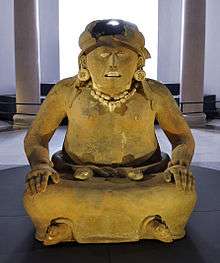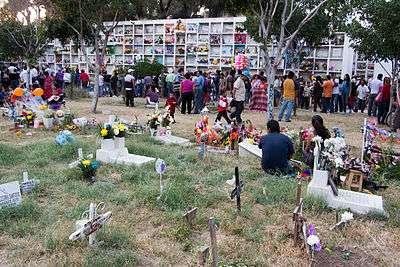Ghosts in Mexican culture
There is an extensive and varied belief in ghosts in Mexican culture. The modern state of Mexico is inhabited by peoples such as the Maya and Nahua. Their beliefs in a supernatural world has survived and evolved, combined with the Catholic beliefs of the Spanish conquest. The Day of the Dead incorporates pre-Columbian beliefs with Christian elements. Mexican literature and movies include many stories of ghosts interacting with the living.

Aztec beliefs

After death the soul of the Aztec went to one of three places: Tlalocan, Mictlan, and the sun. The Aztec idea of the afterlife for fallen warriors and women who died in childbirth was that their souls would be transformed into hummingbirds that would follow the sun on its journey through the sky. Those who drowned would go to Tlalocan, the first level of the upper worlds. Souls of people who died from less glorious causes would go to Mictlan, the lowest level of the underworld, taking four years and passing through many obstacles to reach this place.[1]
The Cihuateteo, spirits of human women who died in childbirth, were not benevolent. On five specified days of the Aztec calendar they descended to earth and haunted crossroads, hoping to steal children whom they had not been able to have themselves.[2]
The Cantares Mexicanos is an important collection of lyric poetry transcribed from Náhuatl into Roman letters around 1550 CE, about 30 years after the fall of Tenochtitlan. In his 1985 edition of these poems, John Bierhorst interprets the poems as "ghost songs" that were intended to summon the spirits of dead Aztec warriors back to earth to help their descendants under Spanish rule. If the songs were successful the ghosts would descend from heaven fully armed and ready to fight, demanding payment in human sacrifice.[3] This interpretation is, however, controversial.[4]
Maya beliefs
The traditional Maya live in the continual presence of the "(grand)fathers and (grand)mothers", the usually anonymous, bilateral ancestors, who, in the highlands, are often conceived of as inhabiting specific mountains, where they expect the offerings of their descendants. In the past, too, the ancestors had an important role to play, with the difference that, among the nobility, genealogical memory and patrilineal descent were much more emphasized. Thus, the Popol Vuh lists three genealogies of upper lords descended from three ancestors and their wives.[5]
These first male ancestors - ritually defined as "bloodletters and sacrificers" - had received their private deities in a legendary land of origins called "The Seven Caves and Seven Canyons" (Nahua Chicomoztoc), and on their disappearance, left a sacred bundle. In Chiapas, at the time of the Spanish conquest, lineage ancestors were believed to have emerged from the roots of a ceiba tree.[5] Comparable beliefs still exist amongst the Tz'utujiles.[6]
Day of the Dead

The Day of the Dead (Spanish: El Día de los Muertos), is a holiday celebrated in Mexico and by Latin Americans living in the United States and Canada. The holiday focuses on gatherings of family and friends to pray for and remember friends and family members who have died. The celebration occurs on November 2 in connection with the Catholic holidays of All Saints' Day (November 1) and All Souls' Day (November 2).
Traditions connected with the holiday include building private altars honoring the deceased using sugar skulls, marigolds, and the favorite foods and beverages of the departed, and visiting graves with these as gifts. Due to occurring shortly after Halloween, the Day of the Dead is sometimes thought to be a similar holiday, although the two actually have little in common. The Day of the Dead is a time of celebration, where partying is common.
The Day of the Dead celebrations in Mexico can be traced back to the indigenous cultures. Rituals celebrating the deaths of ancestors have been observed by these civilizations perhaps for as long as 2500–3000 years.[7] The festival that became the modern Day of the Dead fell in the ninth month of the Aztec calendar, about the beginning of August, and was celebrated for an entire month. The festivities were dedicated to the god.[8] known as the "Lady of the Dead," corresponding to the modern Catrina.
People go to cemeteries to communicate with the souls of the departed who are paying a holiday visit home. The descendants build private altars, containing the favorite foods and beverages, as well as photos and memorabilia, of the departed. The intent is to encourage visits by the souls, so that the souls will hear the prayers and the comments of the living directed to them.[9]
In most regions of Mexico, November 1 honors children and infants, whereas deceased adults are honored on November 2. This is indicated by generally referring to November 1 mainly as "Día de los Inocentes" (Day of the Innocents) but also as "Día de los Angelitos" (Day of the Little Angels) and November 2 as "Día de los Muertos" or "Día de los Difuntos" (Day of the Dead).[9]
Modern ghost legends
La Llorona

"La Llorona" is Spanish for "The Crying Woman" and is a popular legend in Spanish-speaking cultures in the colonies of the Americas, with many versions extant. The basic story is that La Llorona was a beautiful woman who killed her children to be with the man that she loved and was subsequently rejected by him. He might have been the children's father who had left their mother for another woman, or he might have been a man she loved but who was uninterested in a relationship with a woman with children, and whom she thought she could win if the children were out of the way.[10]
She drowned the children and then, after being rejected anyway, killed herself. She is doomed to wander, vainly searching for her children for all eternity. Her constant weeping is the reason for her name. In some cases, according to the tale, she will kidnap wandering children or children who misbehave.[10]
La Planchada
"La Planchada" is Spanish for "the ironed lady". Contrary to what people may assume because of the legend's title, La Planchada was not a woman who was crushed, rather it is similar to La Llorona. Legend says it was a nurse who was attracted to a doctor and he rejected her, or a disgruntled nurse, or a nurse who killed her patient. Many variations of how she was created exist, but one consistent theme is that her ghost appears in many hospitals, though mainly in the metropolitan areas, especially in Mexico City.[11]
Many hospitals such as Hospital Juárez claim she appears there in her old 1930s/60s nurse uniform, which is perfectly ironed (hence the name "La Planchada") and heals patients in the emergency sections. Just as there are claims about how she was turned into a ghost, there are many others in which eyewitnesses claim she appears. Some say she emits a sort of glow. Others say she looks like a normal nurse. Others say she floats, while others say she walks normally, but her steps are never heard. This happens at night and the next morning patients feel better and are taken to another room for further recovery. When asked why they feel better, patients say that "a nurse came in and healed me", but no one in the hospital was either guarding the room or no nurse came at the time the incident happened.[11]
Vanishing hitchhiker
In the Mexican version of the Vanishing hitchhiker urban legend, the hitchhiker is a beautiful woman, who chats with a stranger in a taxi. When she leaves as a normal person she leaves her address. When the person tries to reach the woman at her home, he is informed the woman is dead and that it is also the anniversary of her death.[12]
Cemetery hauntings
Often there are ghost legends associated with the older cemeteries. For example, the Panteón de Belén (also Santa Paula Cemetery), a historical cemetery located in Guadalajara, Mexico, is the site of legends and night tours. The cemetery was opened in 1848 and it was formally closed in 1896. Legends that are part of the local folklore include the Vampire, The Pirate, The Lovers, The Monk, The Child afraid of the Dark, The Story of José Cuervo, The Nun and many more.[13]
In the arts
Woman Hollering Creek and Other Stories is a book of short stories published in 1991 by San Antonio-based Mexican-American writer Sandra Cisneros. The title story is a modern version of the legend of La Llorona.[14]
Hasta el viento tiene miedo (Even the Wind has Fear or Even the Wind is Scared) is a 1968 Mexican horror film, written and directed by Carlos Enrique Taboada. The film is about a ghost that seeks revenge in a school for girls. A remake was released for the Halloween season of 2007 with Martha Higareda as the protagonist.[15]
Kilometer 31 (Kilómetro 31 or km 31) is a 2007 Mexican horror film, written and directed by Rigoberto Castañeda.[16] The film is inspired by the Crying Woman legend (La Llorona) and legends about highway ghosts.[17]
References
- Geoffrey W. Conrad, Arthur Andrew Demarest (1984). Religion and empire: the dynamics of Aztec and Inca expansionism. Cambridge University Press. ISBN 0-521-31896-3.CS1 maint: uses authors parameter (link)
- "Deity Figure (Cihuateotl), 15th–early 16th century". The Metropolitan Museum of Art. Retrieved 2010-03-13.
- John Bierhorst (1985). Cantares mexicanos. Stanford University Press. ISBN 0-8047-1182-8.
- John Curl (2005). Ancient American poets. Bilingual Press. ISBN 1-931010-21-8.
- Sir John Eric Sidney Thompson (1975). Maya Hieroglyphic Writing. Forgotten Books. p. 71. ISBN 1-60506-860-8.
- Robert S. Carlson, and Martin Prechtel, 'The Flowering of the Dead: An Interpretation of Highland Maya Culture'. Man 26-1 (1991): 22-42.
- Miller, Carlos (2005). "History: Indigenous people wouldn't let 'Day of the Dead' die". Day of the Dead — Día De Los Muertos. The Arizona Republic. Retrieved 2007-11-28.
- Salvador, R. J. (2003). John D. Morgan and Pittu Laungani (ed.). Death and Bereavement Around the World: Death and Bereavement in the Americas. Death, Value and Meaning Series, Vol. II. Amityville, New York: Baywood Publishing Company. pp. 75–76. ISBN 0-89503-232-5. Archived from the original on 2007-06-30. Retrieved 2007-11-27.
- Palfrey, Dale Hoyt (1995). "The Day of the Dead". Día de los Muertos Index. Access Mexico Connect. Retrieved 2007-11-28.
- "La Llorona - Weeping Woman of the Southwest". Legends of America. Retrieved 2010-04-10.
- "La Planchada enfermera fantasma". Lanza del Destino (in Spanish). Retrieved 2011-04-06.
- Jan Harold Brunvand (1981). The vanishing hitchhiker: American urban legends and their meanings. W. W. Norton & Company. ISBN 0-393-95169-3.
- "The History of Santa Paula Cemetery". Retrieved 2015-01-02.
- Sandra Cisneros (2008). Woman Hollering Creek and Other Stories. Paw Prints. ISBN 978-1-4395-0807-7.
- Hasta el viento tiene miedo on IMDb
- EyeForFilm.co.uk interview with director Rigoberto Castañeda about KM31 and Blackout.
- Carmen Sánchez Dávila. “No hay peor miedo que al fracaso”, asegura Rigoberto Castañeda director de “Kilómetro 31”. Archived 2010-06-21 at the Wayback Machine February 15, 2007. Filmeweb.